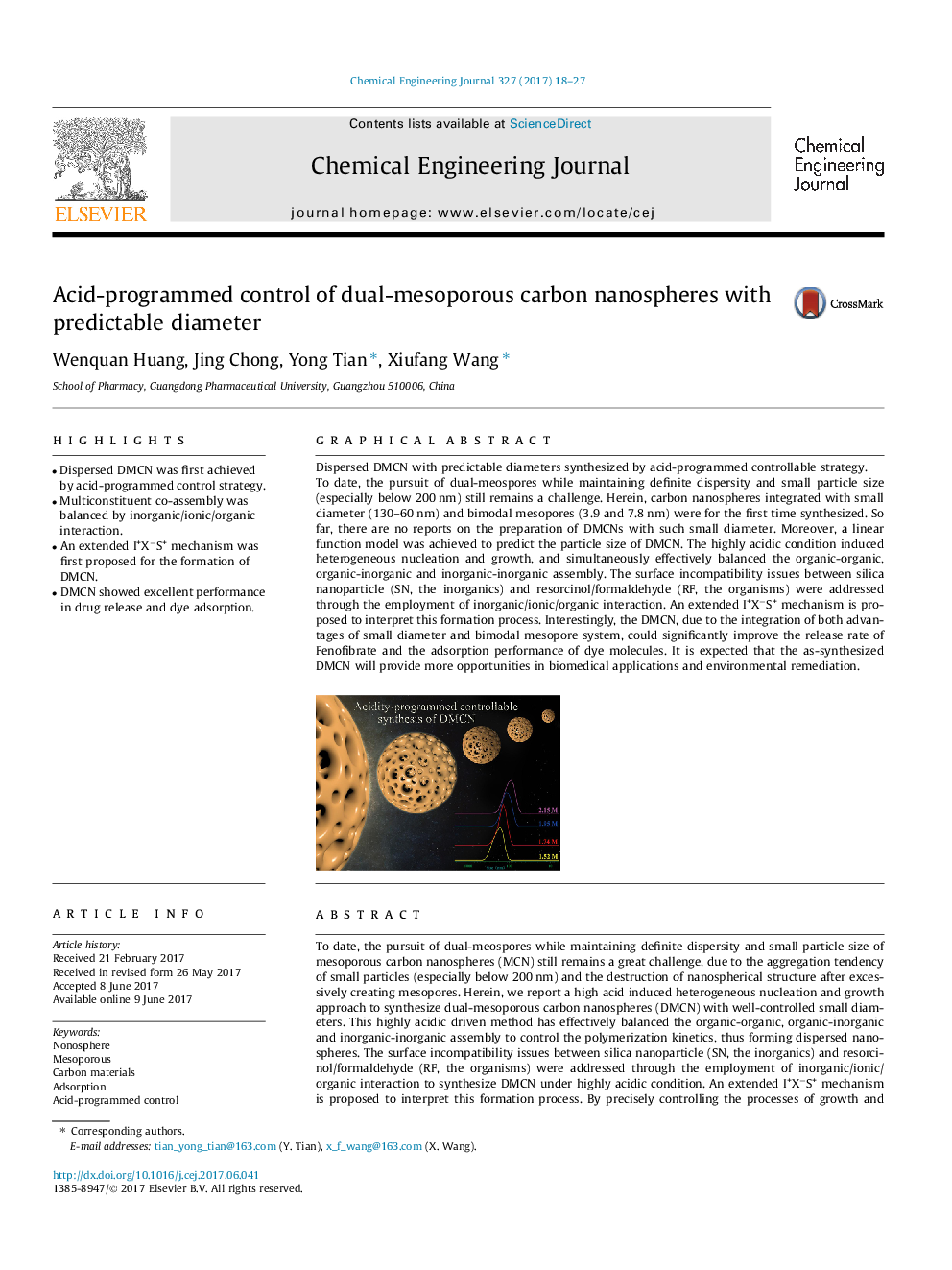| کد مقاله | کد نشریه | سال انتشار | مقاله انگلیسی | نسخه تمام متن |
|---|---|---|---|---|
| 6465175 | 1422951 | 2017 | 10 صفحه PDF | دانلود رایگان |
- Dispersed DMCN was first achieved by acid-programmed control strategy.
- Multiconstituent co-assembly was balanced by inorganic/ionic/organic interaction.
- An extended I+XâS+ mechanism was first proposed for the formation of DMCN.
- DMCN showed excellent performance in drug release and dye adsorption.
To date, the pursuit of dual-meospores while maintaining definite dispersity and small particle size of mesoporous carbon nanospheres (MCN) still remains a great challenge, due to the aggregation tendency of small particles (especially below 200Â nm) and the destruction of nanospherical structure after excessively creating mesopores. Herein, we report a high acid induced heterogeneous nucleation and growth approach to synthesize dual-mesoporous carbon nanospheres (DMCN) with well-controlled small diameters. This highly acidic driven method has effectively balanced the organic-organic, organic-inorganic and inorganic-inorganic assembly to control the polymerization kinetics, thus forming dispersed nanospheres. The surface incompatibility issues between silica nanoparticle (SN, the inorganics) and resorcinol/formaldehyde (RF, the organisms) were addressed through the employment of inorganic/ionic/organic interaction to synthesize DMCN under highly acidic condition. An extended I+XâS+ mechanism is proposed to interpret this formation process. By precisely controlling the processes of growth and cooperation-assembly, the diameter can be easily manipulated over a wide range (130-60Â nm), which is a facile route for preparing dispersed small-size DMCN. Meanwhile, a linear function model is established to quantitatively control and predict the particle size. Since the DMCN integrated both the advantages of small diameter (nanosize effect) and bimodal mesopore system (reduction of transport limitation) in one single unit, it exhibits an excellent performance in the release of poorly water-soluble drug and the adsorption of dye molecules.
Dispersed DMCN with predictable diameters synthesized by acid-programmed controllable strategy.To date, the pursuit of dual-meospores while maintaining definite dispersity and small particle size (especially below 200Â nm) still remains a challenge. Herein, carbon nanospheres integrated with small diameter (130-60Â nm) and bimodal mesopores (3.9 and 7.8Â nm) were for the first time synthesized. So far, there are no reports on the preparation of DMCNs with such small diameter. Moreover, a linear function model was achieved to predict the particle size of DMCN. The highly acidic condition induced heterogeneous nucleation and growth, and simultaneously effectively balanced the organic-organic, organic-inorganic and inorganic-inorganic assembly. The surface incompatibility issues between silica nanoparticle (SN, the inorganics) and resorcinol/formaldehyde (RF, the organisms) were addressed through the employment of inorganic/ionic/organic interaction. An extended I+XâS+ mechanism is proposed to interpret this formation process. Interestingly, the DMCN, due to the integration of both advantages of small diameter and bimodal mesopore system, could significantly improve the release rate of Fenofibrate and the adsorption performance of dye molecules. It is expected that the as-synthesized DMCN will provide more opportunities in biomedical applications and environmental remediation.150
Journal: Chemical Engineering Journal - Volume 327, 1 November 2017, Pages 18-27
